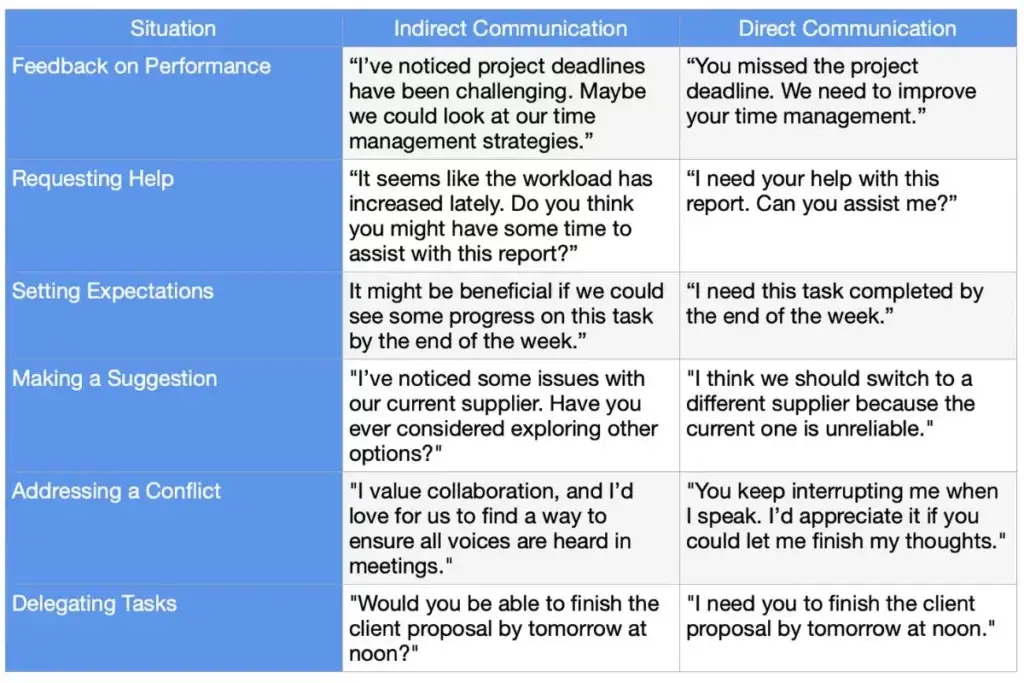In the diverse landscape of professional communication, understanding different speaking styles is crucial. While some situations call for direct messaging, others benefit from a more nuanced approach. You may wonder if your speaking style is effective in your work setting. The answer may lie in a variety of elements. While direct communication may be straightforward, at times, a situation may call for an indirect style. can enhance both direct and indirect communication. At Corporate Speech Matter Expert, the Foundational Speaking Skills Program provides essential techniques to help professionals enhance both direct and indirect communication skills. .

Indirect and Direct Communication Defined
Indirect communication is characterized by subtlety. Messages are often conveyed through hints, suggestions, or implied meanings rather than straightforward statements. This style prioritizes politeness and harmony while avoiding confrontation. It is particularly useful in sensitive situations where direct communication might seem too harsh. However, it can sometimes lead to misunderstandings and inefficiency.
Conversely, direct communication is explicit and straightforward. It leaves little room for ambiguity, making it efficient for decision-making and problem-solving. Clarity and transparency encourage honesty, helping to resolve issues quickly. However, some may perceive it as blunt or abrasive, particularly in cultures that favor indirectness.
Examples of Indirect and Direct Communication

Which is Best in the Professional Setting?
The effectiveness of indirect versus direct communication largely depends on the specific professional context and the individuals involved. Below are key considerations for determining the best approach:
1. Cultural Context
With globalization, professionals frequently interact with colleagues from different cultural backgrounds. For example, direct communication is often preferred in Western cultures, while indirect communication is more common in Asian cultures. According to a Harvard article, understanding these differences is key to preventing miscommunication and fostering collaboration. Take time to observe your workplace culture and adjust your style accordingly.
2. Organizational Culture
Companies with hierarchical structures may benefit from indirect communication to maintain authority and harmony, whereas startups and innovative organizations often favor direct communication for speed and efficiency. As businesses evolve, identifying and developing future leaders becomes essential. According to Forbes, understanding how different generations communicate and lead is crucial for long-term organizational success. If you’re in a leadership role, recognizing the communication styles of emerging leaders can help shape a workplace culture that balances clarity with collaboration.
3. Situational Context
Sensitive discussions may require indirect communication to maintain relationships, while urgent matters often demand directness. If a project is in its final stages and requires immediate decisions, a more direct approach will facilitate efficiency and clarity. However, when building long-term partnerships, a balance between both styles can be more effective.
4. Individual Preferences
Tailoring your communication style to colleagues and stakeholders enhances understanding and collaboration. Whether networking at events, engaging in small talk, or presenting ideas, adapting your approach strengthens professional relationships. If you want to refine your conversational skills and build stronger connections, our Networking Powerhouse Program can help you master the art of engaging communication.

Where Do We Land?
Both indirect and direct communication styles have their place in professional settings. The key is to assess the context and choose the style that will be most effective in achieving your goals while maintaining positive relationships. The Persuasive Playbook offers strategies to enhance your ability to influence and communicate with impact, whether through direct or indirect means.
At Corporate Speech Matter Expert, we equip professionals with the skills to navigate these nuances and communicate with confidence in any situation. Whether it’s storytelling, persuasive speaking, public speaking, or accent modification, we have a program to help you master the art of professional communication.
